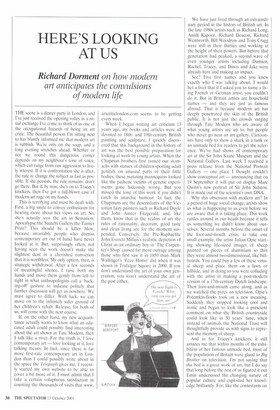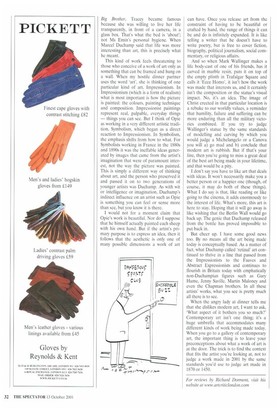HERE'S LOOKING AT US
Richard Dorment on how modem
art anticipates the convulsions of modem life
THE scene is a dinner party in London. and I've just received the opening volley in a ritual exchange I've come to think of as one of the occupational hazards of being an art critic. The beautiful person I'm sitting next to has bluntly informed me that modern art is rubbish. We're only on the soup, and a long evening stretches ahead. Whether or not we round this dangerous corner depends on my neighbour's tone of voice, which can range from raw aggression to lively interest. If it is confrontation she is after, the rule is: change the subject as fast as possible. If she persists, the rule remains: don't go there. But if, by now, she's on to Tracey's knickers, then I've got a full-blown case of modern-art rage on my hands.
This is terrifying and must be dealt with. First, a big smile to convey enthusiasm for hearing more about her views on art. So, she's actually seen the art in Sensation/ Apocalypse/the Saatchi Gallery/the Turner Prize? This should be a killer blow, because invariably people who dismiss contemporary art out of hand have never looked at it. But, surprisingly often, not having seen the work doesn't make the slightest dent in a cherished conviction that it is worthless. My only option, then, is strategic withdrawal. After a few seconds of meaningful silence, I raise both my hands and move them gently from left to right in what anthropologists call a 'backing-off' gesture to indicate politely that further discussion will get us nowhere. We must agree to differ. With luck, we can move on to the infinitely safer ground of her children's rehab. Release, for both of us, will come with the next course.
If, on the other hand, my new acquaintance actually wants to know what an educated adult could possibly find interesting about the art shown at Tate Modern, then I talk like a river. For the truth is, I love contemporary art — love looking at it, love talking means. In fact, since there is far more first-rate contemporary art in London than I could possibly write about in the space the Telegraph gives me, I recently started my own website to be able to cover a bit more of it. I must admit that I take a certain voluptuous satisfaction in counting the thousands of visits that www. artcriticlondon.com seems to be getting every week.
When I began writing art criticism 13 years ago, my books and articles were all devoted to 18thand 19th-century British painting and sculpture. I quickly discovered that this background in the history of art was the best possible preparation for looking at work by young artists. When the Chapman brothers first turned our stomachs with statues of children sporting adult genitals on unusual parts of their little bodies, these mutating mannequins looked like the pathetic victims of genetic experiments gone hideously wrong. But you missed the tone of this work if you didn't catch its anarchic humour. In fact. the Chapmans are the descendants of the Victorian fairy painters such as Richard Doyle and John Anster Fitzgerald, and, like them, know that in the realms of art the rules of rationality, decorum, good taste and clean living are for the moment suspended. Conversely. the Pre-Raphaelite John Everett Millais's realistic depiction of Christ as an ordinary boy in 'The Carpenter's Shop' caused far more outrage among those who first saw it in 1850 than Mark Wallinger's 'Ecce Homo' did when it was shown in Trafalgar Square in 2000. If you don't understand the art of your own generation, you won't understand the art of the past either. We have just lived through an extraordinary period in the history of British art. In the late 1980s artists such as Richard Long, Anish Kapoor, Richard Deacon, Richard Wentworth, Bill Woodrow and Tony Cragg were still in their thirties and working at the height of their powers. But before that generation had peaked, a second wave of even younger artists including Damien, Rachel, Tracey, and Dinos and Jake were already here and making an impact.
See? Five first names and you knew exactly who I was talking about. I would bet a fiver that if I asked you to name a living French or German artist, you couldn't do it. But in Britain artists are household names — and they are just as famous abroad. That is because modern art has deeply penetrated the skin of the British public. It is not just the crowds surging through Tate Modern who are aware of what young artists are up to, but people who never go near an art gallery. Cartoonists have only to show a shark in a tank or an unmade bed for readers to get the reference. We've had shows of contemporary art at the Sir John Soane Museum and the National Gallery. Last week I received a press release from the National Portrait Gallery — one place I thought couldn't show conceptual art — announcing that on 19 September it will put on display Marc Quinn's new portrait of Sir John Sulston. It is made out of the scientist's own DNA.
Why this obsession with modern art? In a period of huge social change, artists show us what is happening to us even before we are aware that it is taking place. This work rattles around in our heads because it tells us something we didn't know about ourselves. Several months before the onset of the foot-and-mouth crisis, to take one small example, the artist Julian Opie starting showing life-sized images of sheep painted on pieces of aluminium so thin they were almost two-dimensional, like billboards. You could buy a few of these virtual sheep and place them on a lawn or hillside, and in doing so you were colluding with the artist in making a post-modern version of a 17th-century Dutch landscape. Then foot-and-mouth came along, and as we watched the pyres on television, Opie's Potemkin-flocks took on a new meaning. Suddenly they stopped looking cool and ironic and began to look like a prescient comment on what the British countryside could look like in 50 years' time, when instead of animals the National Trust will thoughtfully provide us with signs to represent the memory of sheep.
And as for Tracey's knickers, it still amazes me that within months of the exhibition of her famous unmade bed, most of the population of Britain were glued to Big Brother on television. I'm not saying that the bed is a great work of art, but I do say that long before the rest of us figured it out Emin understood the changing nature of popular culture and exploited her knowledge brilliantly. For, like the contestants on Big Brother, Tracey became famous because she was willing to live her life transparently, in front of a camera, in a glass box. That's what the bed is 'about': not Ms Emin's personal hygiene. When Marcel Duchamp said that life was more interesting than art, this is precisely what he meant.
This kind of work feels threatening to those who conceive of a work of art only as something that can be framed and hung on a wall. When my hostile dinner partner uses the word 'art', she is thinking of one particular kind of art, Impressionism. In Impressionism (which is a form of realism) what is most important is how the picture is painted: the colours, painting technique and composition. Impressionist paintings represent real, palpable, everyday things — things you can see. But I think of Opie as working in a very different artistic tradition, Symbolism, which began as a direct reaction to Impressionism. In Symbolism, the emphasis shifts from how to what. For Symbolists working in France in the 1880s and 1890s it was the ineffable ideas generated by images that came from the artist's imagination that were of paramount interest, not the way the picture was painted. This is simply a different way of thinking about art, and the person who preserved it and passed it on to two generations of younger artists was Duchamp. As with wit or intelligence or imagination, Duchamp's indirect influence on an artist such as Opie is something you can feel or sense more than see, but you know it is there.
I would not for a moment claim that Opie's work is beautiful. Nor do I suppose that he himself actually painted each sheep with his own hand. But if the artist's primary purpose is to express an idea, then it follows that the aesthetic is only one of many possible dimensions a work of art can have. Once you release art from the constraint of having to be beautiful or crafted by hand, the range of things it can be and do is infinitely expanded. It is like telling a writer that he doesn't have to write poetry, but is free to cover fiction, biography, political journalism, social commentary, or religious affairs.
And so when Mark Wallinger makes a life body-cast of one of his friends, has it carved in marble resin, puts it on top of the empty plinth in Trafalgar Square and calls it 'Ecce Homo', it isn't how the work was made that interests us, and it certainly isn't the composition or the statue's visual impact. No, it's an idea. The image of Christ erected in that particular location is a rebuke to our worldly values, a reminder that humility, failure and suffering can be more enduring than all the military victories combined. If you try to judge Wallinger's statue by the same standards of modelling and carving by which you would judge a Michelangelo or a Canova you will a) go mad and b) conclude that modern art is rubbish. But if that's your line, then you're going to miss a great deal of the best art being made in your lifetime, and that would be a pity.
I don't say you have to like art that deals with ideas. It won't necessarily make you a better person or a happier one (though, of course, it may do both of these things). What I do say is that, like reading or like going to the cinema, it adds enormously to the interest of life. What's more, this art is here to stay. Hoping that it will go away is like wishing that the Berlin Wall would go back up. The genie that Duchamp released from the bottle has proved impossible to put back in.
But cheer up. I have some good news too. By no means all the art being made today is conceptually based. As a matter of fact, what Duchamp called `retinal' art continued to thrive in a line that passed from the Impressionists to the Fauves and Abstract Expressionists and continues to flourish in Britain today with emphatically non-Duchampian figures such as Gary Hume, Jenny Saville, Martin Maloney and even the Chapman brothers. In all these artists' works, what you see is pretty much all there is to see.
When the angry lady at dinner tells me that she dislikes modern art, I want to ask, 'What aspect of it bothers you so much?' Contemporary art isn't one thing; it's a huge umbrella that accommodates many different kinds of work being made today. When you go to a gallery of contemporary art, the important thing is to leave your preconceptions about what a work of art is at the door. The trick is to find the context that fits the artist you're looking at, not to judge a work made in 2001 by the same standards you'd use to judge art made in 1870 or 1450.
For reviews by Richard Dorment, visit his website at www.artctiticlondon.com



























































































 Previous page
Previous page